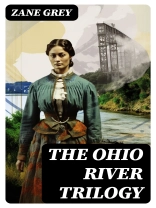In 'The Ohio River Trilogy, ’ Zane Grey masterfully weaves a narrative that immerses readers in the historical and geographical richness of the Ohio River region. The trilogy, comprising three interconnected novels, delves into the lives of rugged pioneers and the stark realities they face in their pursuit of adventure and fulfillment. Grey’s prose combines vivid imagery with a romanticized view of frontier life, reflecting the themes of courage, struggle, and the indomitable human spirit. Contextually, this work emerges from the early 20th century American literature that sought to glorify the rugged individualism and natural beauty of the American landscape, positioning Grey as a key figure in American Western fiction. Zane Grey, an adventurous spirit and passionate sport fisherman, drew inspiration from his own experiences while navigating the great American outdoors. His fascination with storytelling and his desire to depict the American frontier’s nuanced tapestry fueled his writing. Grey’s background in medicine and his family roots in Ohio provide him with a unique perspective, capturing the essence of early American life. This trilogy is an essential read for those captivated by historical narratives that celebrate the spirit of exploration and conquest. Grey’s evocative storytelling not only entertains but also serves as a testament to the resilience of early Americans, making it a vital addition to the library of anyone interested in American history and literature.
O autorze
Zane Grey, born Pearl Zane Gray on January 31, 1872, in Zanesville, Ohio, was a seminal figure in the popularization of the Western genre. His name has become synonymous with the romance and adventure of the American frontier. Trained as a dentist, Grey found greater passion in the craft of storytelling. He initially struggled with publishing but achieved considerable fame with his novel, 'Riders of the Purple Sage’ (1912), which cemented his place in literary history. Over the course of his career, Grey published more than 90 books, capturing the imagination of millions and drawing from personal experiences and historical research. His prose was noted for its visual vividness and the verisimilitude of the Old West. Among his works, 'The Ohio River Trilogy’ comprising 'Betty Zane’ (1903), 'The Spirit of the Border’ (1906), and 'The Last Trail’ (1909), showcases his storytelling prowess and reflects on the history of his own family. Grey’s literary style is characterized by an idealized portrayal of rugged landscapes, staunch masculinity, moral clarity, and an intrinsic sense of adventure. His novels have been adapted into over 100 films, and his influence extended well beyond his death on October 23, 1939, establishing him as a towering figure in American literature and culture. Zane Grey’s historical significance and prolific output continue to be celebrated and studied for their contributions to the genre and their evocation of the American spirit.












